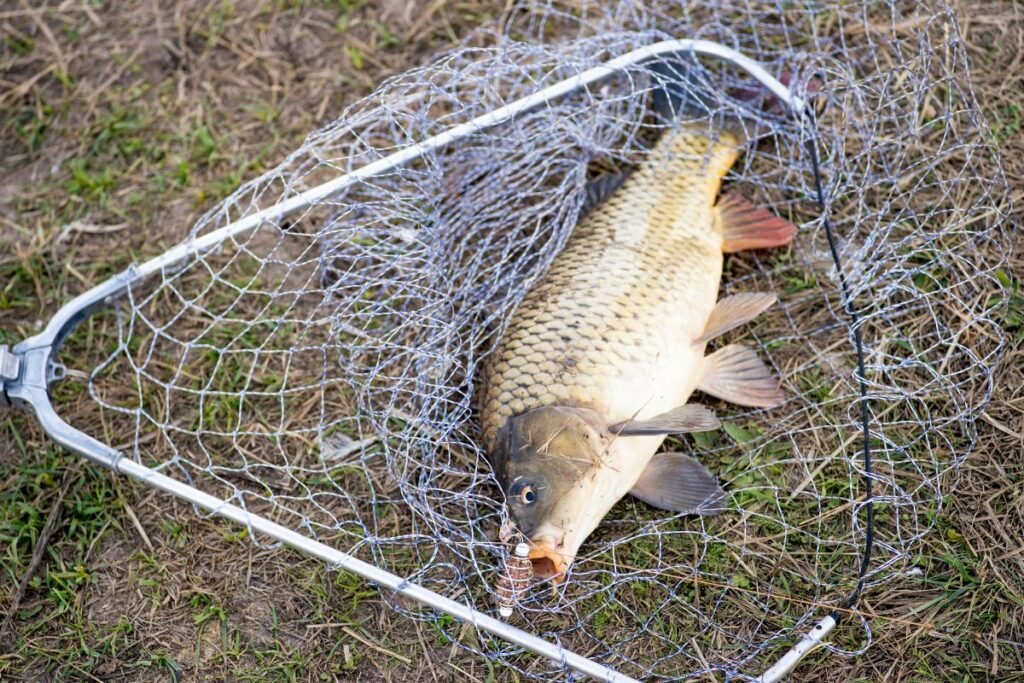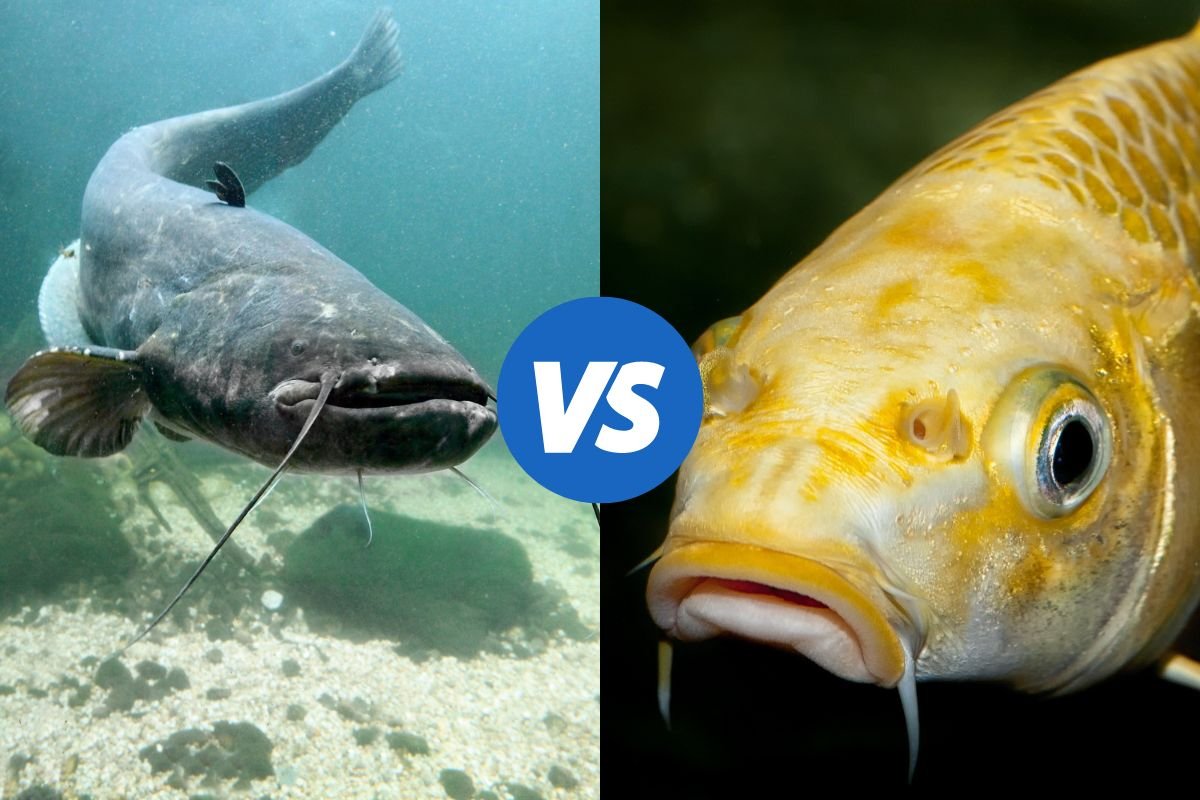Have you ever caught a carp, and thought, what do I do with this thing? At least we all know what to do with catfish though, fish fry!
Catfish Vs Carp
In the vast lakes of the United States, two iconic freshwater species reign supreme: the catfish and the carp. While both species are beloved by anglers and play significant roles in aquatic ecosystems, they possess distinct characteristics that set them apart.
Sit back, while we delve into the fascinating world of catfish and carp, comparing their physical attributes, habitats, behaviors, and angling strategies.
Whether you’re a seasoned angler or a curious nature enthusiast, join us as we uncover the differences between these two remarkable fish species and gain a deeper appreciation for the diversity of freshwater fish.
Physical Characteristics Between Catfish and Carp
Catfish are known for their distinctive barbels, or whisker-like appendages, which adorn their mouths and help them detect prey in murky waters.
These whiskers are a defining feature of catfish and give them their name. Additionally, catfish typically have smooth, scaleless bodies and a wide, flattened head. They come in various sizes, with some species reaching impressive lengths and weights.
Carp, on the other hand, are characterized by their sturdy, torpedo-shaped bodies and large, scales covering their skin. Unlike catfish, carp lack prominent barbels and instead have small, fleshy protrusions near their mouths.
Their mouths are also designed for bottom feeding, and equipped with specialized sensory organs to help them locate food. Carp exhibits a wide range of coloration, from muted tones to vibrant hues, depending on factors such as age, habitat, and diet.
Habitat and Distribution
Catfish are highly adaptable freshwater fish found in a variety of habitats around the world. They prefer slow-moving or still waters such as rivers, lakes, ponds, and swamps, where they can easily scavenge for food along the bottom.
Some species of catfish are also known to inhabit brackish estuaries and even saltwater environments in coastal regions. Their distribution spans across continents, with different species thriving in diverse ecosystems from North and South America to Africa, Europe, and Asia.
Carp are also versatile freshwater fish with a wide habitat range, although they tend to prefer shallow, vegetated areas in lakes, rivers, and reservoirs.
They are often found in slow-moving or stagnant waters with ample vegetation for cover and food sources. Carp have been introduced to numerous regions worldwide for aquaculture and sport fishing purposes, contributing to their widespread distribution.
While native to Asia and Europe, various carp species have been introduced and established populations on nearly every continent, including North America, Australia, and Africa.
Diet and Feeding Behavior
Catfish are opportunistic feeders with a diverse diet that varies depending on their species and habitat. They are primarily bottom-feeders, using their sensitive barbels to locate food such as insects, crustaceans, small fish, and plant matter in murky waters.
Catfish are well-known scavengers and will consume carrion and organic debris. Some larger species of catfish are also known to prey on smaller fish, mollusks, and even birds or small mammals if the opportunity arises.
Their nocturnal feeding behavior allows them to hunt and forage under the cover of darkness, using their keen senses to detect prey in low-light conditions.
Carp are omnivorous fish with a voracious appetite and adaptable feeding habits. They primarily feed on a wide variety of plant matter, including aquatic vegetation, algae, and submerged roots.
Carp also consume insects, crustaceans, small fish, and detritus, using their specialized pharyngeal teeth to grind and crush food. They are often observed rooting through sediments and vegetation in search of food, stirring up bottom substrates with their barbels and powerful mouths.
Carp are known to feed actively throughout the day, although their feeding patterns may vary depending on factors such as water temperature, availability of food sources, and predation pressure.

Reproduction and Lifecycle
Fish, like catfish, exhibit a range of reproductive strategies depending on their species and environmental conditions. Typically, catfish reproduce through external fertilization, with males fertilizing eggs released by females during spawning.
Spawning usually occurs in the warmer months when water temperatures are optimal for egg development. Some species of catfish construct nests or burrows in which to deposit their eggs, while others scatter their eggs over vegetation or substrate.
After fertilization, catfish eggs undergo an incubation period before hatching into larvae. The larvae are initially small and vulnerable, relying on yolk reserves for nutrition until they can begin feeding independently.
As they grow, young catfish undergo various developmental stages before reaching maturity and reproductive age.
Carp have a similar reproductive process to catfish, typically spawning during the spring and early summer months in temperate regions. Spawning behavior varies among carp species but often involves the release of eggs and milt (sperm) into shallow, vegetated areas or along the edges of water bodies.
Female carp may produce thousands of eggs during a single spawning event, which are then fertilized externally by male carp.
The fertilized eggs adhere to vegetation or substrate, where they undergo incubation until hatching. Newly hatched carp larvae are relatively small and vulnerable, requiring protection from predators and suitable habitat conditions for survival.
Over time, carp larvae grow and develop, transitioning through various stages of juvenile and adult life before reaching sexual maturity and participating in the reproductive cycle themselves.
Economic and Ecological Importance
In most cases, catfish play a significant role in both commercial and recreational fisheries, contributing to the economy through the sale of fish products and supporting livelihoods in many regions.
As a popular food fish, catfish are harvested for human consumption, with the farming of species like channel catfish and catfish hybrids being particularly prevalent. Additionally, catfish are valued in aquaculture systems for their fast growth rates and adaptability to various environmental conditions.
Ecologically, catfish contribute to aquatic food webs as both predators and prey, helping to regulate populations of smaller fish and invertebrates. Their bottom-feeding behavior also plays a role in nutrient cycling and sediment disturbance, influencing the health and productivity of aquatic ecosystems.
Carp have significant economic and ecological importance worldwide, although their impacts can vary depending on the context. In some regions, carp are cultivated as a food source and contribute to the aquaculture industry, providing protein-rich products for human consumption.
However, carp are also considered invasive species in many freshwater ecosystems, where they can outcompete native species for resources and disrupt ecological balance.
Despite their invasive status, carp populations support recreational fisheries in some areas, attracting anglers who seek the challenge of catching these large and resilient fish. Additionally, carp play a role in nutrient cycling and habitat modification, influencing water quality and ecosystem dynamics.
Overall, managing carp populations effectively is essential for balancing their economic benefits with their potential ecological impacts.
Cultural and Culinary Significance
Catfish hold cultural significance in many regions where they are a traditional food item and feature prominently in local cuisines. In the Southern United States, catfish dishes are celebrated as comfort food, with popular preparations including fried catfish, catfish stew, and blackened catfish.
Catfish festivals and cook-offs are common events in areas where catfish farming and fishing are prevalent, serving as cultural gatherings that celebrate the culinary heritage of the region.
Additionally, catfish have inspired folklore and stories, becoming symbolic figures in the cultural narratives of communities that rely on freshwater resources for sustenance and livelihoods.
Carp have a long history of cultural significance in various parts of the world, particularly in Asia and Europe, where they are revered for their symbolism and culinary value. In Asian cultures, carp are associated with prosperity, longevity, and good fortune, often depicted in art and literature as auspicious symbols.
In culinary traditions, carp are prepared in a variety of ways, including steaming, frying, and stewing, with dishes like carp soup and sweet and sour carp being popular in some regions.
Carp festivals and rituals are held in some cultures to honor the fish and its symbolic significance, reflecting the deep cultural connections that exist between people and carp throughout history.
Catfish Vs Carp Nutritional Stats
| Category | Catfish | Carp |
|---|---|---|
| Protein (g) | 22 | 19 |
| Fat (g) | 6 | 5 |
| Calories | 150 | 140 |
| Carbohydrates (g) | 0 | 0 |
| Vitamin A (%) | 4 | 2 |
| Vitamin C (%) | 2 | 1 |
| Calcium (%) | 2 | 1 |
| Iron (%) | 4 | 3 |

Conservation Status and Management
The conservation status of catfish varies depending on the species and its habitat. While some catfish species are abundant and widely distributed, others face threats such as habitat loss, pollution, overfishing, and invasive species.
Conservation efforts for catfish often focus on habitat restoration, water quality improvement, and sustainable fishing practices. Additionally, regulations and management measures are implemented to protect catfish populations and their habitats, including catch limits, size restrictions, and fishing gear regulations.
Collaborative initiatives between government agencies, conservation organizations, and local communities play a crucial role in conserving catfish species and maintaining the health of freshwater ecosystems where they reside.
Carp: Carp populations face similar conservation challenges as catfish, including habitat degradation, overfishing, pollution, and the spread of invasive species.
In some regions, carp are considered invasive and pose significant threats to native aquatic biodiversity and ecosystem health. Efforts to manage carp populations often involve control measures such as the removal of invasive individuals, the implementation of barriers to prevent their spread, and the promotion of sustainable fishing practices.
Conservation strategies also aim to restore degraded habitats, mitigate pollution, and raise awareness about the ecological impacts of invasive species.
Collaborative management approaches involving government agencies, conservation groups, researchers, and local communities are essential for addressing the conservation issues associated with carp and ensuring the long-term sustainability of freshwater ecosystems.
Want to learn more about Catfish? Check out Catfish Vs Tilapia
Wrapping It Up
In conclusion, catfish and carp are two distinct species of freshwater fish that play important ecological, economic, and cultural roles around the world.
While they share some similarities in their habitats, diets, and ecological interactions, they also exhibit unique characteristics and behaviors that make them fascinating subjects of study and management.
Both catfish and carp face conservation challenges due to human activities such as habitat destruction, pollution, overfishing, and the introduction of invasive species. Efforts to conserve these fish species require coordinated actions at local, regional, and global levels, including habitat restoration, sustainable fisheries management, pollution control, and invasive species management.
By implementing effective conservation measures and promoting responsible stewardship of aquatic ecosystems, we can ensure the continued survival of catfish and carp populations and maintain the health and resilience of freshwater environments for future generations.


